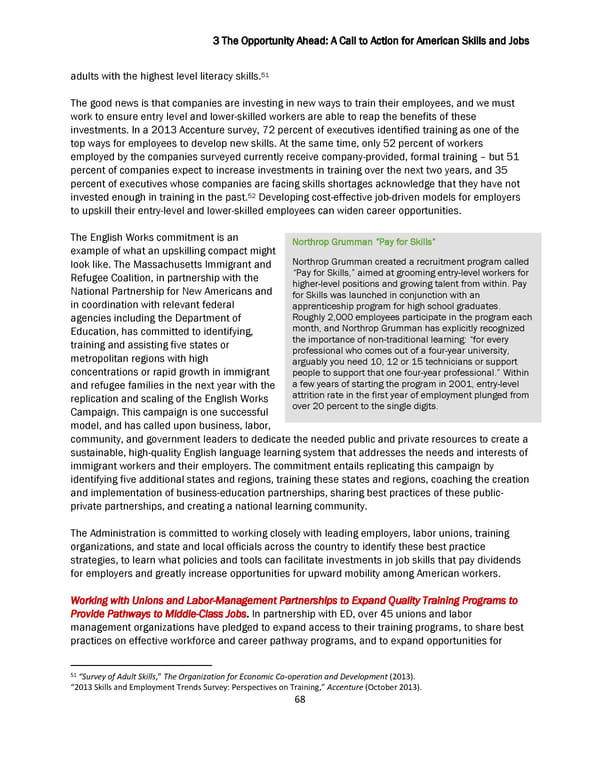3 The Opportunity Ahead: A Call to Action for American Skills and Jobs 51 adults with the highest level literacy skills. The good news is that companies are investing in new ways to train their employees, and we must work to ensure entry level and lower-skilled workers are able to reap the benefits of these investments. In a 2013 Accenture survey, 72 percent of executives identified training as one of the top ways for employees to develop new skills. At the same time, only 52 percent of workers employed by the companies surveyed currently receive company-provided, formal training – but 51 percent of companies expect to increase investments in training over the next two years, and 35 percent of executives whose companies are facing skills shortages acknowledge that they have not 52 invested enough in training in the past. Developing cost-effective job-driven models for employers to upskill their entry-level and lower-skilled employees can widen career opportunities. The English Works commitment is an Northrop Grumman “Pay for Skills” example of what an upskilling compact might look like. The Massachusetts Immigrant and Northrop Grumman created a recruitment program called Refugee Coalition, in partnership with the “Pay for Skills,” aimed at grooming entry-level workers for National Partnership for New Americans and higher-level positions and growing talent from within. Pay in coordination with relevant federal for Skills was launched in conjunction with an apprenticeship program for high school graduates. agencies including the Department of Roughly 2,000 employees participate in the program each Education, has committed to identifying, month, and Northrop Grumman has explicitly recognized training and assisting five states or the importance of non-traditional learning: “for every metropolitan regions with high professional who comes out of a four-year university, arguably you need 10, 12 or 15 technicians or support concentrations or rapid growth in immigrant people to support that one four-year professional.” Within and refugee families in the next year with the a few years of starting the program in 2001, entry-level replication and scaling of the English Works attrition rate in the first year of employment plunged from Campaign. This campaign is one successful over 20 percent to the single digits. model, and has called upon business, labor, community, and government leaders to dedicate the needed public and private resources to create a sustainable, high-quality English language learning system that addresses the needs and interests of immigrant workers and their employers. The commitment entails replicating this campaign by identifying five additional states and regions, training these states and regions, coaching the creation and implementation of business-education partnerships, sharing best practices of these public- private partnerships, and creating a national learning community. The Administration is committed to working closely with leading employers, labor unions, training organizations, and state and local officials across the country to identify these best practice strategies, to learn what policies and tools can facilitate investments in job skills that pay dividends for employers and greatly increase opportunities for upward mobility among American workers. Working with Unions and Labor-Management Partnerships to Expand Quality Training Programs to Provide Pathways to Middle-Class Jobs. In partnership with ED, over 45 unions and labor management organizations have pledged to expand access to their training programs, to share best practices on effective workforce and career pathway programs, and to expand opportunities for 51 “Survey of Adult Skills,” The Organization for Economic Co-operation and Development (2013). “2013 Skills and Employment Trends Survey: Perspectives on Training,” Accenture (October 2013). 68
 Biden Ready to Work White Paper 7/22/14 Page 67 Page 69
Biden Ready to Work White Paper 7/22/14 Page 67 Page 69